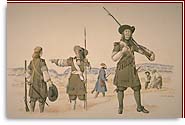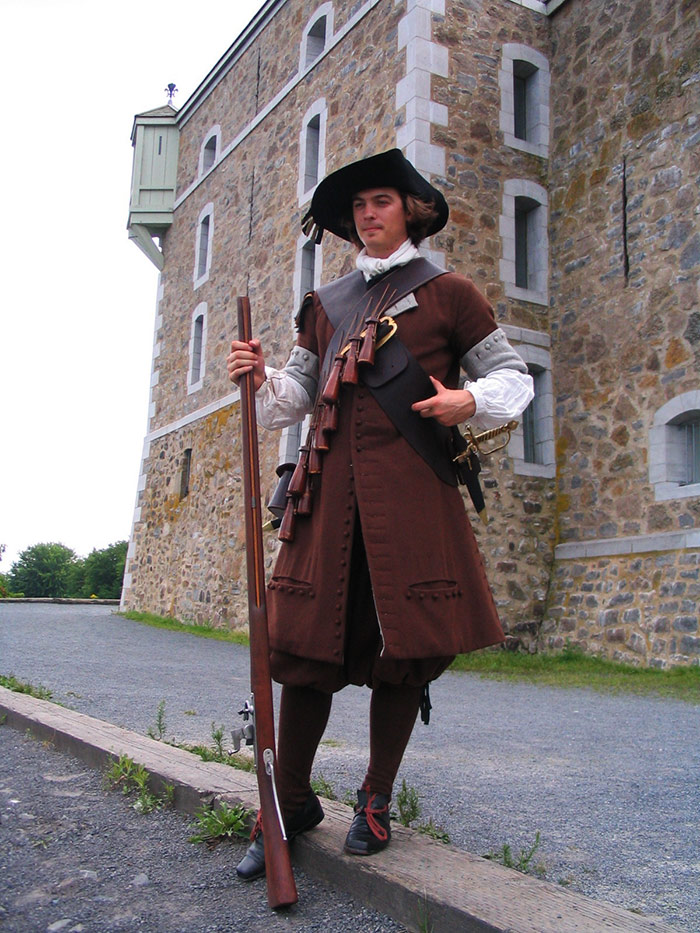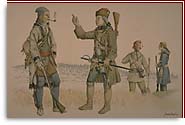
Soldiers and Militia
Fort Chambly National Historic Site
The Carignan-Salières regiment
 Officer and Soldiers from the Carignan-Salières Regiment, Between 1665 and 1668
Officer and Soldiers from the Carignan-Salières Regiment, Between 1665 and 1668© Francis Back

Since 1641, New France had lived continually under the threat of the Iroquois. In 1665, King Louis XIV sent out 1200 soldiers of the Carignan-Salières Regiment to crush the Iroquois.
This regiment set about building a chain of forts along the Richelieu River to head off invasion by the Iroquois. It launched two attacks against the Iroquois. Peace was finally re-established in 1667.
Once the mission was accomplished, the king had hoped to retain some of his troops in New France to start up a colony. He allocated enough supplies for the soldiers for one year, as well as a bonus according to rank. More than 400 decided to stay.
Captain Jacques de Chambly was one of the officers. In 1672, he was granted the Chambly Seigneury in recognition of his service to the crown. The following year he, in turn, conveyed 29 parcels of this land, 15 to former soldiers.
Most of the soldiers were single and of marrying age. Between 1663 and 1673, shiploads of des Filles du roi or King's maidens were sent out from France to re-establish the fragile demographics of the colony.
These were the young people who would lay down the roots of this new French colony.
 Sergeant and Soldier from the Compagnies franches de la Marine in New France, Between 1716 and 1730
Sergeant and Soldier from the Compagnies franches de la Marine in New France, Between 1716 and 1730© Parks Canada / Reconstitution of Michel Pétard / XX.R.242
The compagnies franches de la Marine
In 1680, the Iroquois once again started showing signs of agitation. Faced with imminent conflict, Governor Lefebvre de La Barre and Intendant Demeulles pressured the king into sending troops out to the colony.
Their response arrived in 1683 with an initial contingency of 150 soldiers from the Compagnies franches de la Marine, who landed in Quebec. Their mission: to force peace on the Iroquois.
In 1685, these soldiers were stationed at fort Chambly and launched several raids against the Iroquois. A final peace treaty (La Grande Paix de Montréal) was signed in 1701, putting an end to the Iroquois threat.
The Marine troops remained in the French colony until the British Conquest of 1760.
The Canadian Militia
 Canadian Militiamen, First Half of the 18th Century
Canadian Militiamen, First Half of the 18th Century© Parks Canada / Reconstitution of Francis Back / X.82.14.1
In the forest, there was a man who could run silently through the trees. His breechcloth and leggings protected him as he lunged through the branches and underbrush. His moccasins silenced his step, he could take his prey by surprise. Armed with a hatchet, a gun and knife, this man was able to meet the challenge of surviving in the forest, for the love of his country.
Who was this man? All indications would lead one to believe that he was an Indigenous. But no, not at all. He was a militiaman, a member of the Canadian Militia, a man especially adapted to the harsh environment of New France.
The Militia was set up by Louis XIV in 1669, to respond to the need created by the departure of the Carignan-Salières Regiment in 1667. Any man between the ages of 16 and 60 who could bear arms automatically belonged to the company representing his parish. Each company was made up of some fifty militiamen who trained each Sunday after mass. The Canadian Militia quickly became an indispensable force in the defence of the colony. It was also largely due to their presence that New France managed to stay on the world map.
- Date modified :